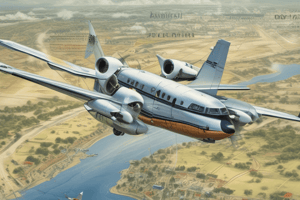Podcast
Questions and Answers
What is essential to prepare for ensuring safety and compliance during a flight?
What is essential to prepare for ensuring safety and compliance during a flight?
- A checklist of in-flight games
- A weight and balance sheet (correct)
- A log of previous flights
- A weather briefing alone
Which navigational aids must be utilized to adequately outline a flight route?
Which navigational aids must be utilized to adequately outline a flight route?
- Radar and barometric pressure
- Only GPS coordinates from a mobile device
- VOR, GPS, or both (correct)
- Visual landmarks only
When developing an emergency plan for a flight, which factor should be included?
When developing an emergency plan for a flight, which factor should be included?
- Environmental conditions only
- Fuel management and flight duration (correct)
- A backup pilot's contact information
- Passenger entertainment options
Which regulation is important to ensure adherence when creating a flight plan?
Which regulation is important to ensure adherence when creating a flight plan?
What should be included in the documentation of a flight plan?
What should be included in the documentation of a flight plan?
What is the primary goal of the flight planning project?
What is the primary goal of the flight planning project?
Which aspect is NOT a part of effective emergency planning?
Which aspect is NOT a part of effective emergency planning?
How should VOR stations or GPS waypoints be applied during navigation planning?
How should VOR stations or GPS waypoints be applied during navigation planning?
What does creating a thorough weight and balance sheet ensure?
What does creating a thorough weight and balance sheet ensure?
What should the reflection component of a flight plan entail?
What should the reflection component of a flight plan entail?
Preparing a flight plan does not require consideration of navigational aids like VOR or GPS.
Preparing a flight plan does not require consideration of navigational aids like VOR or GPS.
Weight and balance calculations are irrelevant once the flight is airborne.
Weight and balance calculations are irrelevant once the flight is airborne.
Emergency planning should include only fuel management strategies.
Emergency planning should include only fuel management strategies.
Documentation of a flight plan should only consist of a navigation log.
Documentation of a flight plan should only consist of a navigation log.
Adhering to regulations such as 14 CFR part 91 is optional in flight planning.
Adhering to regulations such as 14 CFR part 91 is optional in flight planning.
Creating a weight and balance sheet is necessary to ensure the aircraft is within operational limits throughout the flight.
Creating a weight and balance sheet is necessary to ensure the aircraft is within operational limits throughout the flight.
A reflection on the flight planning process should focus solely on technical aspects without personal insights.
A reflection on the flight planning process should focus solely on technical aspects without personal insights.
Peer-reviewing flight plans among students enhances the learning experience through feedback exchange.
Peer-reviewing flight plans among students enhances the learning experience through feedback exchange.
Navigational aids like GPS provide a continuous stream of data throughout the flight without requiring manual input.
Navigational aids like GPS provide a continuous stream of data throughout the flight without requiring manual input.
The primary goal of the flight planning project is to demonstrate a deep understanding of cross-country VFR navigation.
The primary goal of the flight planning project is to demonstrate a deep understanding of cross-country VFR navigation.
What key components should be included on a weight and balance sheet for compliance?
What key components should be included on a weight and balance sheet for compliance?
Describe how you would navigate using a VOR station.
Describe how you would navigate using a VOR station.
In an emergency scenario, what factors should you consider for fuel management?
In an emergency scenario, what factors should you consider for fuel management?
What are the potential consequences of not adhering to 14 CFR part 91 when planning a flight?
What are the potential consequences of not adhering to 14 CFR part 91 when planning a flight?
What should the navigation log include to be comprehensive?
What should the navigation log include to be comprehensive?
Explain the importance of reflection in the flight planning process.
Explain the importance of reflection in the flight planning process.
What is a crucial step in preparing for a diversion to an alternate airport?
What is a crucial step in preparing for a diversion to an alternate airport?
How does peer review of flight plans contribute to student learning?
How does peer review of flight plans contribute to student learning?
Identify a key regulatory guideline that must be followed while creating a flight plan.
Identify a key regulatory guideline that must be followed while creating a flight plan.
What role do emergency communication strategies play in your flight plan?
What role do emergency communication strategies play in your flight plan?
Study Notes
Overview of Comprehensive Flight Planning
- Emphasizes the critical importance of comprehensive flight planning for aspiring commercial pilots.
- Recaps essential concepts from the course to prepare for the final project.
VFR Navigation Fundamentals
- VFR navigation is essential for confident cross-country flying.
- Mastery of sectional aeronautical charts and VFR terminal area charts is crucial.
- Understanding airspace classifications and symbols transforms navigation from challenging to clear.
Navigational Aids
- Familiarity with various navigational aids like VORs and GPS is necessary.
- Use of the 24-hour clock and 360-degree compass to standardize time and direction communication.
Wind Correction and Fuel Planning
- Acknowledges the impact of wind on planned routes and fuel consumption.
- Ability to calculate fuel needs based on wind conditions is vital for safe journeys.
Technical Competence
- Proficiency in using flight computers and manual calculations enhances navigational accuracy.
- Adapting to in-flight contingencies and making real-time adjustments are hallmarks of effective piloting.
Final Project Expectations
- Project involves creating a detailed cross-country flight plan, integrating all acquired skills.
- Key components include: chart interpretation, navigational aid usage, fuel planning, and in-flight adjustments.
Route Selection and Planning
- Choose a route over at least 150 nautical miles, including various airspace classifications and terrains.
- Incorporate easily identifiable checkpoints with justifications for each selection.
Calculation Requirements
- Calculate True Course (TC) for each leg, accounting for geography and airspace.
- Determine True Heading (TH) considering aircraft performance and expected winds.
- Adjust for magnetic variation and compass deviation to ascertain Magnetic Heading.
Wind Correction and Fuel Planning
- Use wind forecast data to calculate necessary wind correction angles.
- Estimate fuel consumption, ensuring adequate reserves alongside regulations.
Weight and Balance Management
- Prepare a weight and balance sheet for operational limits compliance throughout the flight.
Navigational Aids Integration
- Detail the usage of VOR and GPS for route navigation, including relevant frequencies or waypoints.
Emergency Scenario Planning
- Develop a strategy for a potential emergency, focusing on fuel management and communications for diversions.
Regulatory Compliance
- Flight plans must adhere to applicable regulations, notably 14 CFR part 91 and other relevant guidelines.
Documentation and Reflection
- Document the flight plan thoroughly, including navigation log, charts, and weight/balance data.
- Write a reflection on the planning process, decisions made, and application of course content.
Peer Review and Learning Experience
- Engage in peer review for plans, allowing exchange of feedback and insights.
- Aim for comprehensive understanding of cross-country VFR navigation and flight planning nuances.
Overview of Comprehensive Flight Planning
- Emphasizes the critical importance of comprehensive flight planning for aspiring commercial pilots.
- Recaps essential concepts from the course to prepare for the final project.
VFR Navigation Fundamentals
- VFR navigation is essential for confident cross-country flying.
- Mastery of sectional aeronautical charts and VFR terminal area charts is crucial.
- Understanding airspace classifications and symbols transforms navigation from challenging to clear.
Navigational Aids
- Familiarity with various navigational aids like VORs and GPS is necessary.
- Use of the 24-hour clock and 360-degree compass to standardize time and direction communication.
Wind Correction and Fuel Planning
- Acknowledges the impact of wind on planned routes and fuel consumption.
- Ability to calculate fuel needs based on wind conditions is vital for safe journeys.
Technical Competence
- Proficiency in using flight computers and manual calculations enhances navigational accuracy.
- Adapting to in-flight contingencies and making real-time adjustments are hallmarks of effective piloting.
Final Project Expectations
- Project involves creating a detailed cross-country flight plan, integrating all acquired skills.
- Key components include: chart interpretation, navigational aid usage, fuel planning, and in-flight adjustments.
Route Selection and Planning
- Choose a route over at least 150 nautical miles, including various airspace classifications and terrains.
- Incorporate easily identifiable checkpoints with justifications for each selection.
Calculation Requirements
- Calculate True Course (TC) for each leg, accounting for geography and airspace.
- Determine True Heading (TH) considering aircraft performance and expected winds.
- Adjust for magnetic variation and compass deviation to ascertain Magnetic Heading.
Wind Correction and Fuel Planning
- Use wind forecast data to calculate necessary wind correction angles.
- Estimate fuel consumption, ensuring adequate reserves alongside regulations.
Weight and Balance Management
- Prepare a weight and balance sheet for operational limits compliance throughout the flight.
Navigational Aids Integration
- Detail the usage of VOR and GPS for route navigation, including relevant frequencies or waypoints.
Emergency Scenario Planning
- Develop a strategy for a potential emergency, focusing on fuel management and communications for diversions.
Regulatory Compliance
- Flight plans must adhere to applicable regulations, notably 14 CFR part 91 and other relevant guidelines.
Documentation and Reflection
- Document the flight plan thoroughly, including navigation log, charts, and weight/balance data.
- Write a reflection on the planning process, decisions made, and application of course content.
Peer Review and Learning Experience
- Engage in peer review for plans, allowing exchange of feedback and insights.
- Aim for comprehensive understanding of cross-country VFR navigation and flight planning nuances.
Overview of Comprehensive Flight Planning
- Emphasizes the critical importance of comprehensive flight planning for aspiring commercial pilots.
- Recaps essential concepts from the course to prepare for the final project.
VFR Navigation Fundamentals
- VFR navigation is essential for confident cross-country flying.
- Mastery of sectional aeronautical charts and VFR terminal area charts is crucial.
- Understanding airspace classifications and symbols transforms navigation from challenging to clear.
Navigational Aids
- Familiarity with various navigational aids like VORs and GPS is necessary.
- Use of the 24-hour clock and 360-degree compass to standardize time and direction communication.
Wind Correction and Fuel Planning
- Acknowledges the impact of wind on planned routes and fuel consumption.
- Ability to calculate fuel needs based on wind conditions is vital for safe journeys.
Technical Competence
- Proficiency in using flight computers and manual calculations enhances navigational accuracy.
- Adapting to in-flight contingencies and making real-time adjustments are hallmarks of effective piloting.
Final Project Expectations
- Project involves creating a detailed cross-country flight plan, integrating all acquired skills.
- Key components include: chart interpretation, navigational aid usage, fuel planning, and in-flight adjustments.
Route Selection and Planning
- Choose a route over at least 150 nautical miles, including various airspace classifications and terrains.
- Incorporate easily identifiable checkpoints with justifications for each selection.
Calculation Requirements
- Calculate True Course (TC) for each leg, accounting for geography and airspace.
- Determine True Heading (TH) considering aircraft performance and expected winds.
- Adjust for magnetic variation and compass deviation to ascertain Magnetic Heading.
Wind Correction and Fuel Planning
- Use wind forecast data to calculate necessary wind correction angles.
- Estimate fuel consumption, ensuring adequate reserves alongside regulations.
Weight and Balance Management
- Prepare a weight and balance sheet for operational limits compliance throughout the flight.
Navigational Aids Integration
- Detail the usage of VOR and GPS for route navigation, including relevant frequencies or waypoints.
Emergency Scenario Planning
- Develop a strategy for a potential emergency, focusing on fuel management and communications for diversions.
Regulatory Compliance
- Flight plans must adhere to applicable regulations, notably 14 CFR part 91 and other relevant guidelines.
Documentation and Reflection
- Document the flight plan thoroughly, including navigation log, charts, and weight/balance data.
- Write a reflection on the planning process, decisions made, and application of course content.
Peer Review and Learning Experience
- Engage in peer review for plans, allowing exchange of feedback and insights.
- Aim for comprehensive understanding of cross-country VFR navigation and flight planning nuances.
Studying That Suits You
Use AI to generate personalized quizzes and flashcards to suit your learning preferences.
Related Documents
Description
Welcome to the final module of VFR Mastery, focusing on Comprehensive Flight Planning essential for aspiring commercial pilots. In this session, we will recap important concepts and skills developed throughout the course to ensure effective cross-country flying. Prepare to enhance your flight planning techniques and situational awareness as we conclude this training.




